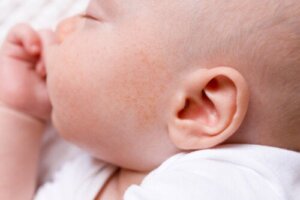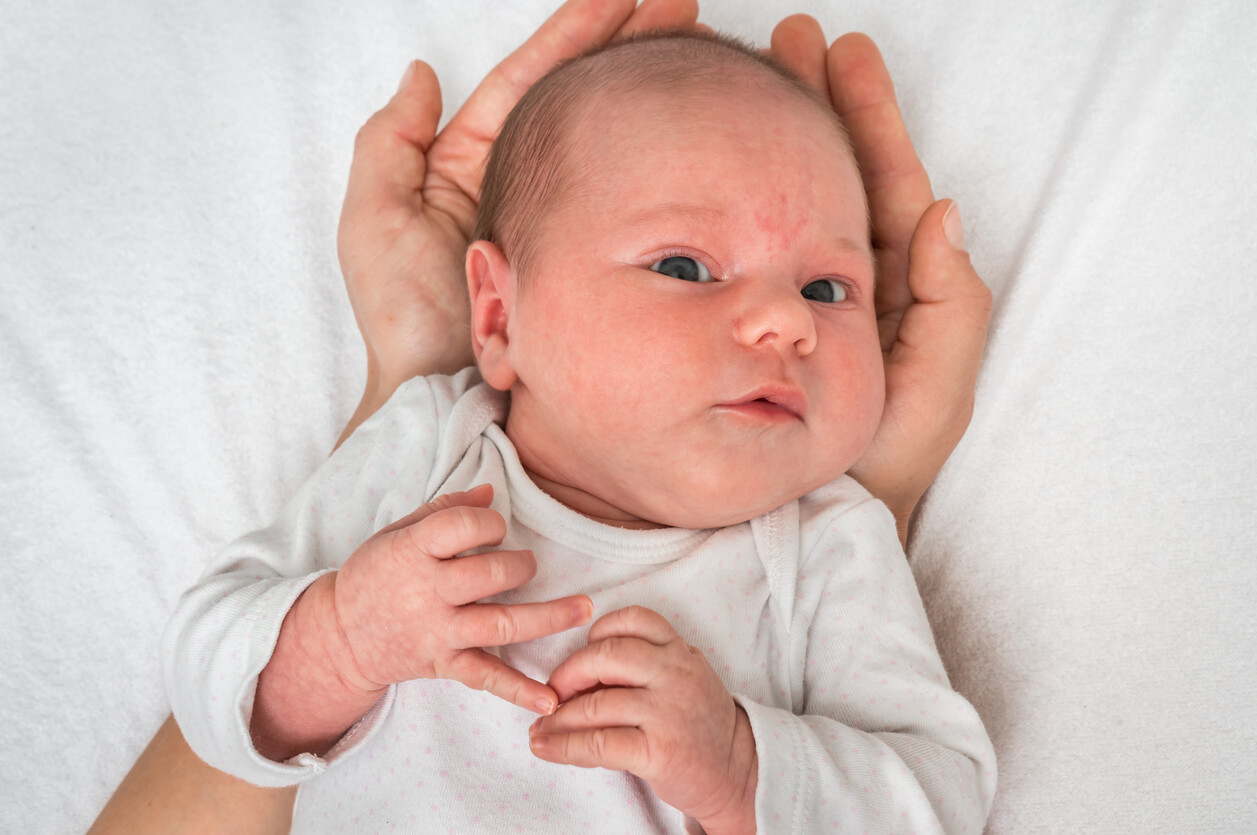Pimples on a Baby's Face: Causes and Treatment


Written and verified by the dermatologist Maria del Carmen Hernandez
Newborn skin is delicate and soft. However, during the first days of life, pimples on a baby’s face may often appear, causing concern and anxiety in new parents. While some of them resolve on their own, others will require specific treatment. We’ll tell you more in this article.
Causes of pimples on a baby’s face
The baby’s skin is in the process of adapting to life outside the womb and, during this period, lesions appear that tend to resolve on their own over time. Here are some of these conditions.
Milium cysts
Milium are small white cysts on the skin. They don’t usually last long but cause concern for parents. Also, they don’t require treatment because they resolve on their own within a few weeks. One of the causes attributed to it is that dead skin cells get trapped underneath the skin and form cysts.
Infant acne
Infant acne is also called “neonatal cephalic pustulosis”. It’s a very common condition in newborns and occurs in one in five infants. It usually clears up on its own within the first three months.
You may be interested in: Milia in Babies: What You Should Know

Seborrheic dermatitis
Seborrheic dermatitis can affect the scalp, as well as other areas, and involves itching, flaking of the skin, and inflammation. In addition, it can be found in areas with a high concentration of active sebaceous glands, such as the scalp, the T-line of the face, and the ears.
It’s therefore a chronic, mostly self-limiting, scaly skin condition that appears between the third week and the first two months of life. On physical examination, findings include the accumulation of yellow, greasy scales on the vertex, forehead, and scalp.
Sudamen, sweat vesicles
Sudamen is caused by superficial, momentary obstruction of eccrine sweat ducts that give rise to rapidly evolving, noninflammatory vesicles.
This type of manifestation occurs more frequently in hot, humid tropical climates and in the neonatal period. This is due to the lack of maturation of the sweat duct during the first days after birth.
Atopic eczema
Atopic dermatitis is a chronic, common skin condition that can significantly alter the quality of life of sufferers and their families. The main feature is intense itching of the skin surface, leading to skin trauma and significant sleep disturbance.
The disorder appears to be the result of the complex interaction between defects in skin barrier function, immune system dysregulation, and environmental and infectious agents.
Read also: Soaps for Children with Atopic Skin

Measures to manage pimples on a baby’s face
There are multiple recommendations to carry out and prevent the appearance of lesions on the baby’s skin. Some of them can be easy and very effective:
- Baths with lukewarm water: Babies don’t need to be bathed every day or from the first day of life. In addition, it’s advisable to use lukewarm water and neutral hypoallergenic soaps that don’t contain dyes or fragrances. Even the duration of rinsing should be short and you should avoid generating friction when drying with a towel.
- Avoid sun exposure: Babies under 6 months of age aren’t allowed to be exposed to the sun. However, older babies should use adequate protection.
- Suitable clothing: The choice of cotton or natural fiber clothing helps to prevent allergic reactions or irritations on the skin surface of babies.
- Rich and varied food: A diet that’s varied and contains all the nutrients and vitamins necessary to avoid illnesses is recommended. Proper hydration is also key.
- Avoid certain products: It’s not a good idea to apply products on the baby’s face that may cause the sebaceous glands to be occluded.
Medical consultation as a premise
Pimples on the baby’s face don’t usually cause any complications and aren’t serious. However, a consultation with a medical specialist should always be sought. If deemed necessary, the doctor will indicate the necessary measures or treatments to be carried out.
Newborn skin is delicate and soft. However, during the first days of life, pimples on a baby’s face may often appear, causing concern and anxiety in new parents. While some of them resolve on their own, others will require specific treatment. We’ll tell you more in this article.
Causes of pimples on a baby’s face
The baby’s skin is in the process of adapting to life outside the womb and, during this period, lesions appear that tend to resolve on their own over time. Here are some of these conditions.
Milium cysts
Milium are small white cysts on the skin. They don’t usually last long but cause concern for parents. Also, they don’t require treatment because they resolve on their own within a few weeks. One of the causes attributed to it is that dead skin cells get trapped underneath the skin and form cysts.
Infant acne
Infant acne is also called “neonatal cephalic pustulosis”. It’s a very common condition in newborns and occurs in one in five infants. It usually clears up on its own within the first three months.
You may be interested in: Milia in Babies: What You Should Know

Seborrheic dermatitis
Seborrheic dermatitis can affect the scalp, as well as other areas, and involves itching, flaking of the skin, and inflammation. In addition, it can be found in areas with a high concentration of active sebaceous glands, such as the scalp, the T-line of the face, and the ears.
It’s therefore a chronic, mostly self-limiting, scaly skin condition that appears between the third week and the first two months of life. On physical examination, findings include the accumulation of yellow, greasy scales on the vertex, forehead, and scalp.
Sudamen, sweat vesicles
Sudamen is caused by superficial, momentary obstruction of eccrine sweat ducts that give rise to rapidly evolving, noninflammatory vesicles.
This type of manifestation occurs more frequently in hot, humid tropical climates and in the neonatal period. This is due to the lack of maturation of the sweat duct during the first days after birth.
Atopic eczema
Atopic dermatitis is a chronic, common skin condition that can significantly alter the quality of life of sufferers and their families. The main feature is intense itching of the skin surface, leading to skin trauma and significant sleep disturbance.
The disorder appears to be the result of the complex interaction between defects in skin barrier function, immune system dysregulation, and environmental and infectious agents.
Read also: Soaps for Children with Atopic Skin

Measures to manage pimples on a baby’s face
There are multiple recommendations to carry out and prevent the appearance of lesions on the baby’s skin. Some of them can be easy and very effective:
- Baths with lukewarm water: Babies don’t need to be bathed every day or from the first day of life. In addition, it’s advisable to use lukewarm water and neutral hypoallergenic soaps that don’t contain dyes or fragrances. Even the duration of rinsing should be short and you should avoid generating friction when drying with a towel.
- Avoid sun exposure: Babies under 6 months of age aren’t allowed to be exposed to the sun. However, older babies should use adequate protection.
- Suitable clothing: The choice of cotton or natural fiber clothing helps to prevent allergic reactions or irritations on the skin surface of babies.
- Rich and varied food: A diet that’s varied and contains all the nutrients and vitamins necessary to avoid illnesses is recommended. Proper hydration is also key.
- Avoid certain products: It’s not a good idea to apply products on the baby’s face that may cause the sebaceous glands to be occluded.
Medical consultation as a premise
Pimples on the baby’s face don’t usually cause any complications and aren’t serious. However, a consultation with a medical specialist should always be sought. If deemed necessary, the doctor will indicate the necessary measures or treatments to be carried out.
All cited sources were thoroughly reviewed by our team to ensure their quality, reliability, currency, and validity. The bibliography of this article was considered reliable and of academic or scientific accuracy.
- American Academy of Dermatology aAssociation. (s. f). How to treat eczema in babies. Consultado el 12 de septiembre de 2023. https://www.aad.org/public/diseases/eczema/childhood/treating/treat-babies
- American Academy of Pediatrics (s. f.). Salpullido y Marcas en el Recién Nacido. Consultado el 12 de septiembre de 2023. https://www.healthychildren.org/Spanish/tips-tools/symptom-checker/Paginas/symptomviewer.aspx?symptom=Salpullido+y+Marcas+en+el+Reci%C3%A9n+Nacido
- American Academy of Pediatrics. (8 de mayo de 2013). Dermatitis seborreica infantil o costra láctea. https://www.healthychildren.org/Spanish/ages-stages/baby/bathing-skin-care/Paginas/cradle-cap.aspx
- Asociación Española de Pediatría. (27 de febrero de 2022). Acné neonatal. https://enfamilia.aeped.es/edades-etapas/acne-neonatal
- Asociación Española de Pediatría (12 de diciembre de 2019). Sudamina. https://enfamilia.aeped.es/temas-salud/sudamina
-
Gallardo, A. P. P., & Mendez, M. D. (31 de enero de 2023). Milia. StatPearls. https://www.ncbi.nlm.nih.gov/books/NBK560481/
- Godínez, J., Vidaurri, H. (2021). Acné en el recién nacido. Boletín Médico del Hospital Infantil de México, 78(5). https://www.scielo.org.mx/scielo.php?script=sci_arttext&pid=S1665-11462021000500443
- Khare, C., Kumar, M., Rustogi, D. (2022). Miliaria Crystallina in a Newborn. The Journal of Pediatrics, 253, 314. https://www.jpeds.com/article/S0022-3476(22)00873-3/fulltext
- Kutlubay, Z., et al. (2017). Newborn Skin: Common Skin Problems. Journal Maedica, 12(1), 42–47. https://www.ncbi.nlm.nih.gov/pmc/articles/PMC5574071/
- Miñana, V. (2012). Trastornos cutáneos más frecuentes del recién nacido y del lactante. Revista Pediatría Integral, XVI(3), 195-208. https://www.pediatriaintegral.es/numeros-anteriores/publicacion-2012-04/trastornos-cutaneos-mas-frecuentes-del-recien-nacido-y-del-lactante-dermatitis-del-panal/
This text is provided for informational purposes only and does not replace consultation with a professional. If in doubt, consult your specialist.








